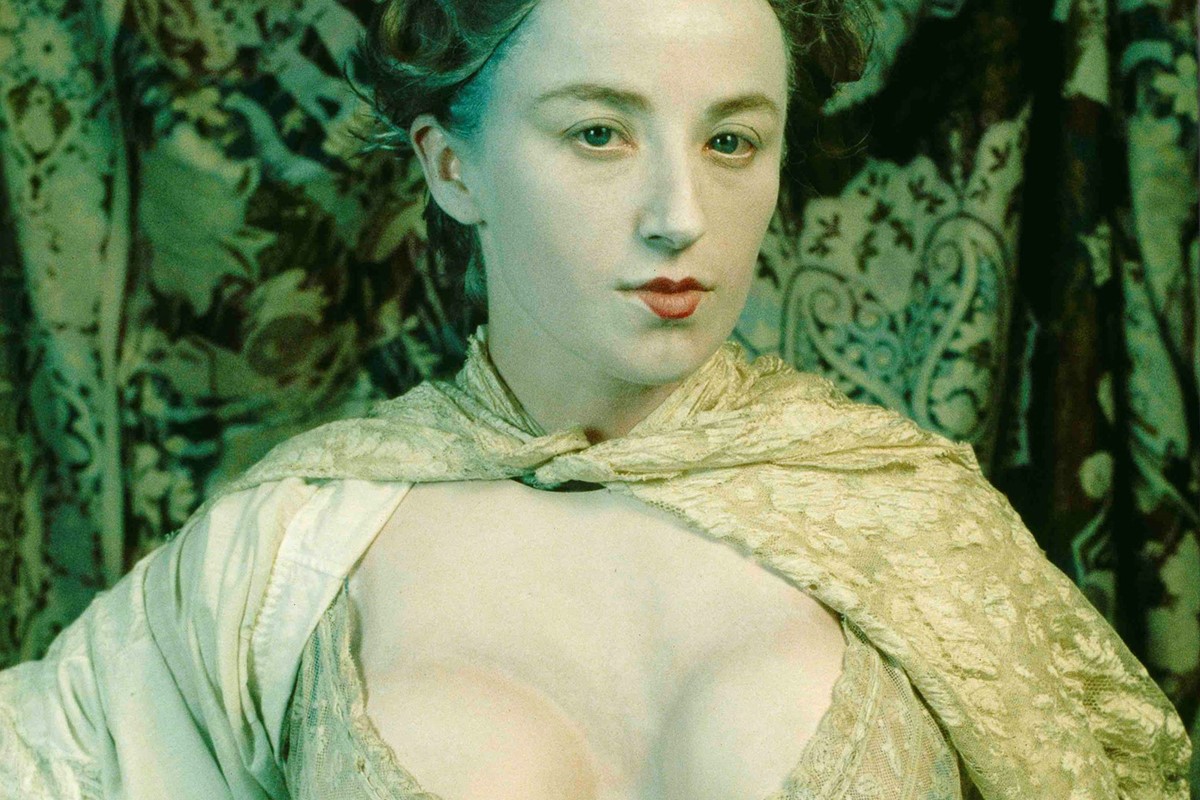
Rewrite
Lead ImageUntitled #183, 1988Cindy Sherman
This interview is taken from Simone Rocha, published by Rizzoli.
Prosthetics, historical costumes, larger-than-life characters. Cindy Sherman is an artist who has been constructing and deconstructing female identities since the 70s. Whether framed as a critique, a defence, or simply an observation, Sherman’s characters — and their commentary on class, ageism, celebrity, and women’s role in society — harness the transformative power of clothing to show the world exactly who they are and how they want to be perceived. “I wish I could treat every day as Halloween and get dressed up and go out into the world as some eccentric character,” she once said.
Pushing the boundaries of the grotesque in her images, Sherman has drawn inspiration from the dark depths of history’s past to the strangeness of contemporary culture. Parodying the voyeurism of male painters, History Portraits (1981) tackled Old Masters portraits with patchy prosthetic breasts and squirting nipples, while her 2008 series Society Portraits put a nine-foot-tall lens on rich and powerful American socialites battling with women’s biggest taboo: ageing.
Much like Sherman, Simone Rocha is also fascinated with the idea of clothing as a signifier of strength and vulnerability — showing sensitivity while perversely pushing the dualities in her work. Subverting Elizabethan dress for Autumn/Winter 2014, she homed in on the toughness of Anne Boleyn and the dramatic proportions of her dress at a time when the only way women could take up space was with their clothing.
The emotional connection between clothing and identity also connects Sherman and Rocha. In 2022, Rocha invited Sherman to contribute works from her Bus Riders (1976) series to her exhibition girls, girls, girls at Lismore Castle Arts; a show that was a provocative ode to women artists like Louise Bourgeois, Harley Weir, and Josiane MH Pozi. With their subversive investigations into identity, womanhood, and dress, Sherman and Rocha talk about where they get inspiration from, the fine line between life and work, and the emotional connection between clothing and identity.
Cindy Sherman: I was thinking this morning, on my way back from the gym, about the first time I encountered your work. I think it was at Dover Street Market. I saw some of your pieces there and I bought a pair of heels — they were acrylic and see-through rubber with some pearls on them!
Simone Rocha: I was so excited and humbled when I found out that you were a customer. I was like, ‘Wow!’ because I’m such a fan. That’s the best bit of the job, when people you admire want to be a part of what you do. It’s the ultimate compliment.
CS: I can’t get enough of your stuff. I don’t know what it is that resonates with me so much, but I always feel really good when I’m wearing your clothes. Sometimes I think maybe I’m too old for some things, but there’s something about your clothes that feels very flattering for my body. You’re one of the few designers I feel I can really depend on when I want to look good and presentable.
SR: For me, clothes are like armour, like a uniform. They have a security to them, but I also love looking at an almost archaic kind of femininity … Cindy, I really wanted to ask you how you feel about clothes, because from the outside they’re such an important part of your work. Is that a tool or a hindrance?
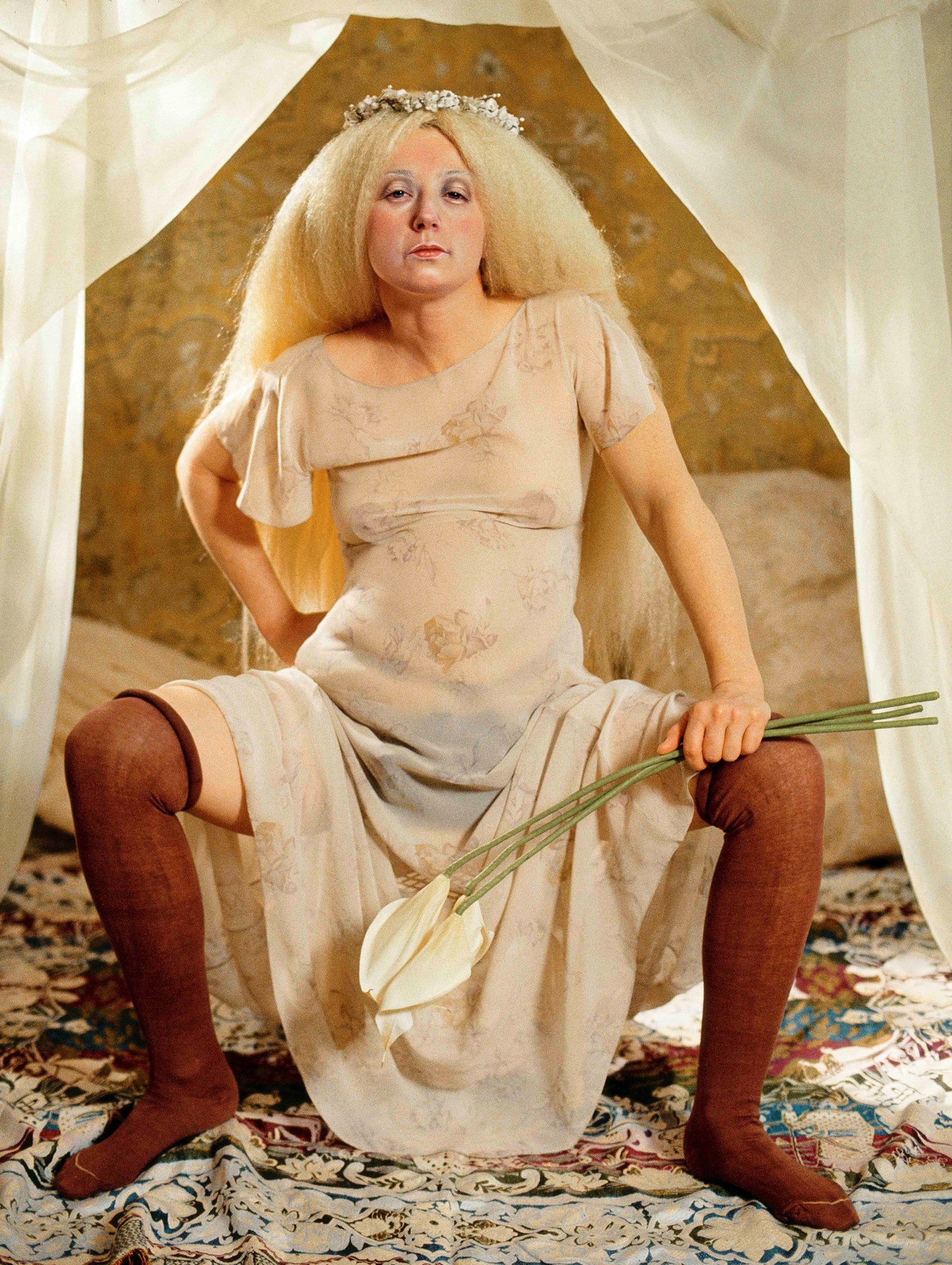
CS: Clothes are definitely a tool in my work. It’s funny, I tend towards a lot of clothing that’s very costumey. There are some things I’ve bought over the years that I’ll probably never wear, like shoes that are just crazy high. Maybe I don’t fit into them anymore, but I’ll never get rid of them because they meant something to me at the time. They’re like pieces of art.
SR: Do you archive them?
CS: I finally got this storage place, so now it’s easy when I want to get something out of it. I just go online to their website and they deliver it to me.
SR: And where do you source clothes?
CS: Sometimes I’ve gone online, like on eBay, but that was more when I did the clown series. I wanted really colourful things, like big striped colourful T-shirts and ruffled square dance dresses that were perfect for some of the female clowns I was doing. If I’m working on something that’s really specific like that, then I’ll search online. Or I go to the Salvation Army and thrift stores, sometimes without anything in mind. If I see something that seems kind of outrageous, perhaps it will inspire a character. Even if I don’t know what I’m going to use it for, I’ll get it. The clothes I wear in my personal life are kind of different.
SR: It might feel too intimate to capture what you wear day to day?
CS: I’m trying to think if I’ve actually done that, because it’s possible. I also tend to cut things up for my costumes and use pant legs as sleeves, for example. I’m definitely not going to do that with some of my finer clothes that I wear for events, but there’s always the possibility.
SR: The series I’ve always felt really connected to are the History Portraits, Untitled Film Stills, and the Bus Riders. In each one, the identities are so extreme and so far apart from each other. As a designer, I felt really connected to the dress in those works, specifically with the History Portraits. How did that evolve?
“I’ve always been a little jealous of people who go to work and have to look nice every day. I feel like I have two sides of myself: the one wearing T-shirts, no makeup, and my hair pulled back, and the other one, where I go out to dinners, openings, or events and I have to look nice and put make-up on” – Cindy Sherman
CS: It started around 1987, when I was doing the Limoges porcelain series. I was inspired by this one design of a tureen that was supposedly designed by Madame de Pompadour, and I wanted to do a portrait based on her. I had this old-fashioned fake bustier that makes it look like you have big cleavage, and I threw some cloth around it. That was what started it and a few years later I continued with that theme. Later, I had a show in Paris that fell around Bastille Day on July 14, so I wanted to do some French Revolution characters. The next year, I was doing a residency in Rome, so then it became Italian-themed, and that’s how the whole series grew. At that time I was using pant legs as big fluffy sleeves, and I would cut things up and put them upside down to try and make them look like those outfits from that period.
SR: What I’ve always found interesting about historical dress is that it was a time when it was difficult for women to vocalise their opinions. Instead, it was about how much space they could take up in a room through dress because they couldn’t take up any space vocally. But they were always very covered up. So I loved the History Portraits where you show the breast.
CS: Thanks. That one with the breast, that’s actually based on a real portrait somewhere that I saw of a woman, just milk squirting out of her tit … How do you get inspiration?
SR: It completely depends. I do a collection once every six months, and each collection is very much a reaction to the previous collection. My Spring/Summer 2023 collection was about this idea of harnessing an emotion that you can’t take control of, and I wanted to do something that was very pastel and sickly sweet. As an antithesis to that, the next season, for Autumn/Winter 2023, I wanted to do something that felt very grounded and planted in the earth. I started looking more at Ireland and its traditions and rituals and how that could translate into physically making and weaving pieces. That’s the last two collections, but the ways I get inspiration change all the time. I love going to markets and flea markets and I have a big vintage archive that I love to turn inside out as well. I’m very physical — I don’t do a lot of sketching, I do nearly all of it on a model — and I write a big body of text on what the collection is about. It’s always on a body in the studio on one of our fit models, but then I’ll wear it, the team will wear it … there’s something about when you’re physically in different pieces, you can really think about the fabrication and the fit. For me, putting a human into it gives it a bit of identity.
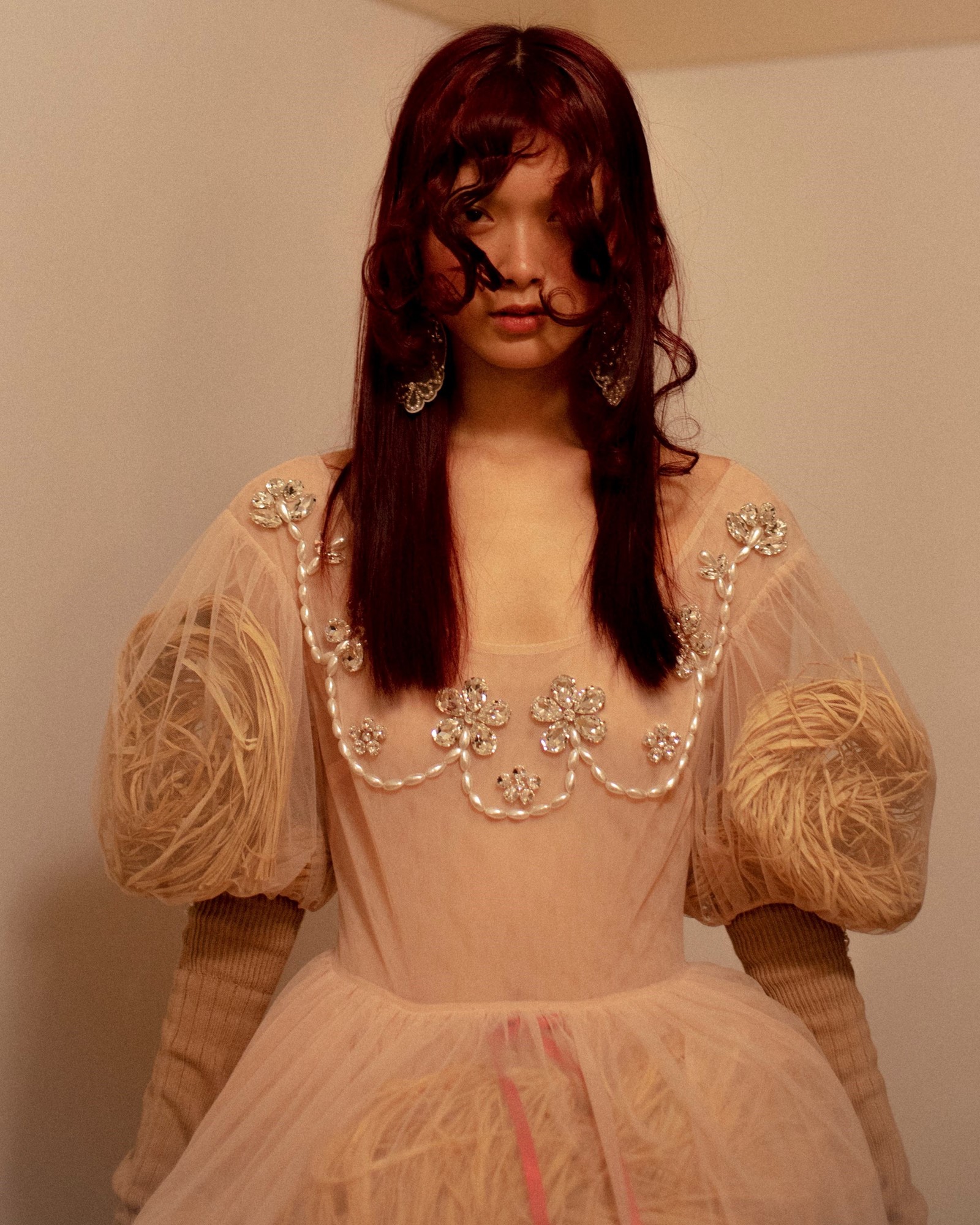
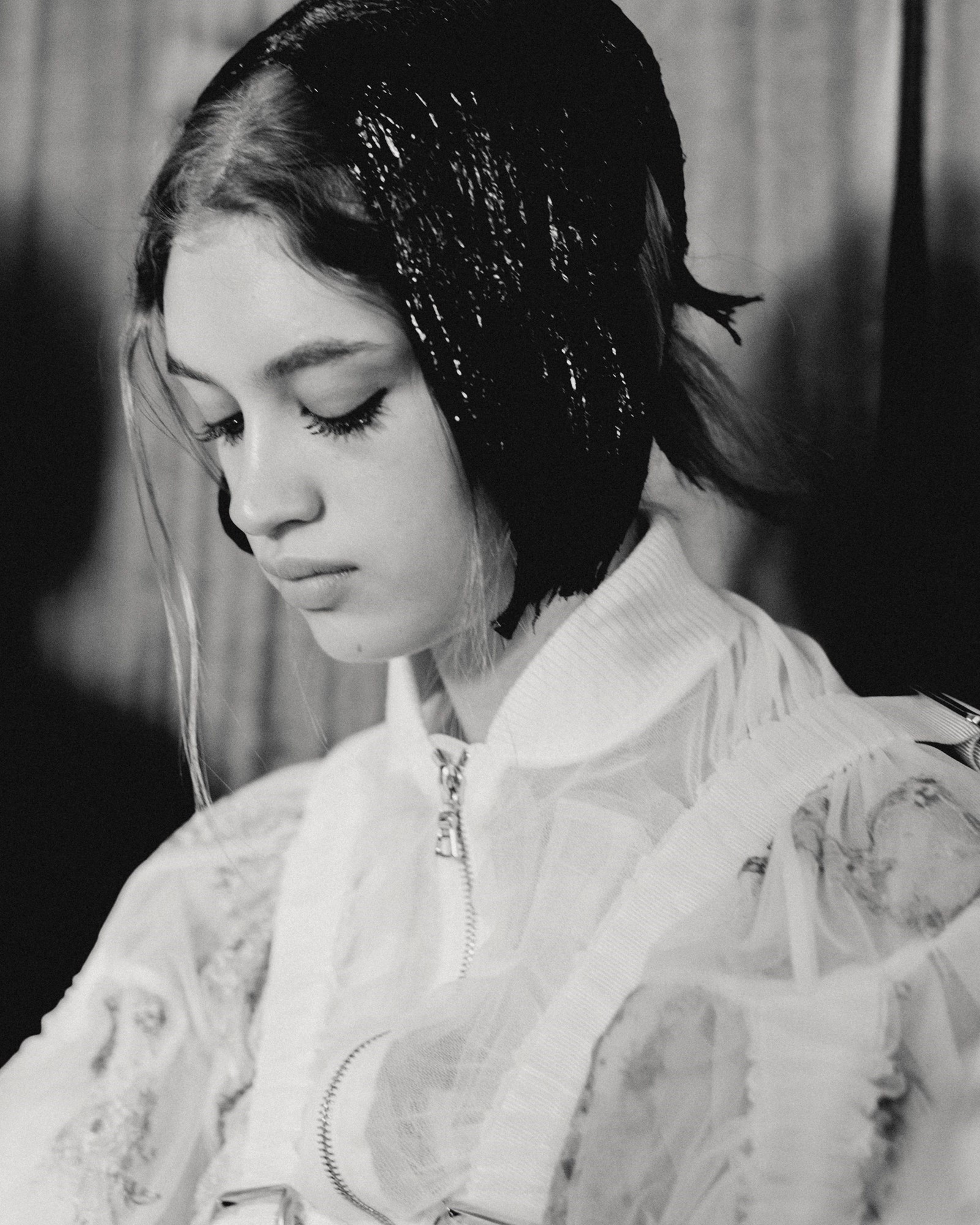
CS: Have there been times when you’re wearing one of your own samples, and you suddenly realise, ‘Maybe this is too tight here’?
SR: Absolutely. And we’re actually so extreme. With some pieces, we’ll get everyone in the studio to wear it for a day or two to see how they feel.
CS: That’s great. It must be very fun working for you. [Laughs].
SR: Or the whole studio will be in a pair of shoes.
CS: Yeah, shoes are fun, too. I have a lot of shoes.
SR: They’re really fun but they’re actually the hardest part to do. They’re so technical, so ergonomic, but I love making playful shoes. So I’m thrilled that your first piece was a pair of shoes, actually. It’s very fitting.
CS: I think one of my favourite pieces right now is a dress I wore about a year ago to my first opening at Hauser & Wirth, the gallery I’m with now. It was the first show I did during the pandemic and even though it was older work, I was still pretty insecure. Especially having gained a little weight during the pandemic, that made me even more insecure. But I just felt so great in this dress. It was just so flattering, it didn’t matter. It was black — perfect! I also have a lot of pieces that I don’t fit into anymore. Some of them I bought like a week before the pandemic, when everything was shutting down, because I was about to have a show in March of 2020 at the Louis Vuitton Foundation in Paris, which was going to be a really big deal. So I wanted a couple of nice, beautiful dresses for being in Paris. Two months later, I was having a new show in New York, and I had all these things. I never wore them because I gained weight, and two years later, they don’t fit me, but I’m holding on to them because I’m determined to. They’re in my closet and I look at them and go, ‘Oh, I wanna wear that!’
SR: We can do an alteration. We can cut the legs off other things and stick them on!
CS: No, I’m determined to get back into shape.
“People are like, ‘Your weight is in your control,’ but it’s not really in your control. It’s hormonal, it’s emotional, and that’s so connected to clothes and identity” – Simone Rocha
SR: People are like, ‘Your weight is in your control,’ but it’s not really in your control. It’s hormonal, it’s emotional, and that’s so connected to clothes and identity. There’s such a fine line between your life and your work when you’re working within this kind of discipline. Sometimes I feel like I have to wear certain things to work, which is crazy. Even though I’m making clothes, you still have to think about what you’re going to wear to be able to do that. Do you feel like you need to wear certain things to work?
CS: Because I work at home and I work alone — I don’t have any assistants around — my uniform for the day is just a T-shirt and simple pants. I’ve always been a little jealous of people who go to work and have to look nice every day. I feel like I have two sides of myself: the one wearing T-shirts, no makeup, and my hair pulled back, and the other one, where I go out to dinners, openings, or events and I have to look nice and put make-up on. It’s like a different version of myself. But I am jealous of people who look nice all the time. When I go into SoHo to the stores to shop, the sales girls and guys look really great and pulled together and I feel so sloppy. And then when I’m actually shooting, it’s completely different because I’m picking out which clothes will create the character I’m trying to do. Sometimes the work is completely determined by the clothing — the clothing alone will give me an idea for the character — but sometimes it’s the wig or some other prop.
SR: How do you feel when you’re at an opening and you have to look at your work with the characters you’ve invented?
CS: It’s a little weird sometimes. I’m definitely used to it now because it’s been so long. I do feel like the pieces on the wall in the gallery are characters. I really don’t identify with them. I don’t feel like it’s me up on the walls, it’s like somebody else. Especially when it’s really old work, I don’t really relate to who I was then anymore… but it’s still kind of weird. This new body of work I just finished made me very self-conscious because of the little extra weight I gained, because I felt like I’ve always weighed the same throughout my whole career. And now that person — the constant of that canvas, which was me — has changed. So it was a little hard going back into shooting again, but I did.
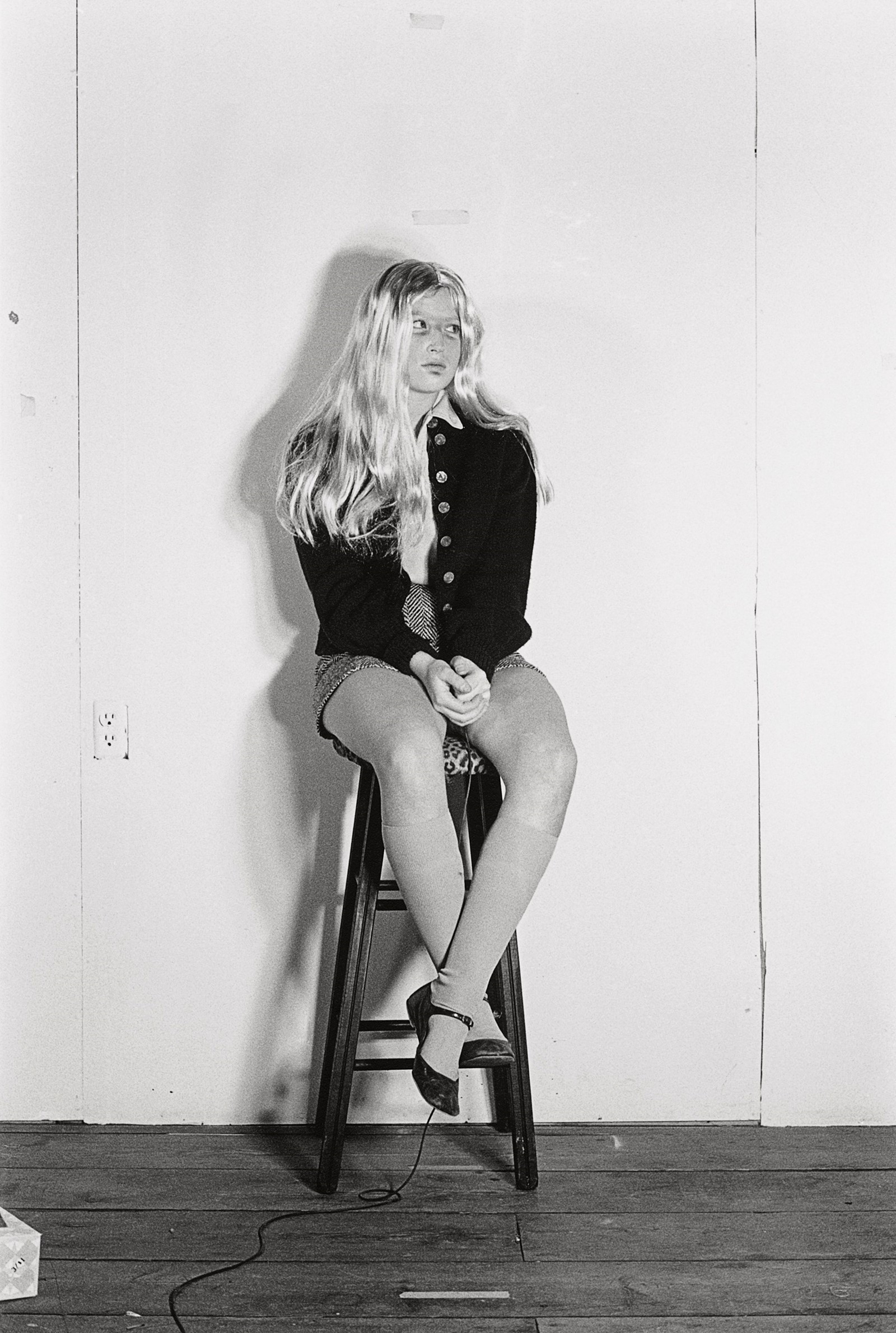

SR: I was so grateful that you contributed to the girls girls girls show I curated at Lismore Castle Arts. I wanted to ask about the Bus Riders series you had in the show?
CS: I actually had a show back in 1976 that was on a bus, where they usually put the advertising above the seats. This was in Buffalo, New York, where I was going to college. I cut out little figures like dolls and glued them to a board on the bus. A couple of months later, people had ripped some of them off, but years later I decided to print out certain characters from that series. I dressed up like old ladies, old men, homosexuals, rebellious kids, women with groceries and housewife types. And I did some Black characters, which I’ve been criticised for. The criticism I got ten years ago was because they thought the white characters had various skin tones and that the Black characters didn’t, but that wasn’t true — I didn’t use any more elaborate skin tones for the white. I realised that at the time it was very naive of me, because there are a variety of Black skin tones. It never occurred to me, so that was really stupid on my part. It’s not really something I’m proud of, so we don’t show those works anymore.
SR: Time is changing so much now that we have to go back and think about all the things.
CS: Hopefully now we’re more aware.
SR: I just loved the realism in them. Some feel really realistic and then others are really cinematic and untouchable, like the Untitled Film Stills. Are they reactions to bodies of your own work?
CS: You mentioned earlier that you were inspired by your previous series, and I feel the same way. With things that I didn’t quite articulate well enough, or things that were a little misunderstood, I tried to go back and take that into consideration. That would definitely inspire the next series, or trigger something in it.
SR: Yeah, I think it’s impossible not to feel that. There’s almost something about a responsibility to the work that you’ve done.
CS: There’s one series I did that I refer to as Centerfolds or Horizontals which got criticism in the beginning from feminist critics who said they were too close to something you’d see in a true detective magazine of women thrown on the ground, looking up in terror. So the next series immediately after that were these more upright, vertical pictures. And the series that came right after that, which I called The Pink Robes, were pictures of women with a pink robe thrown over them, with the idea that they had just finished a photoshoot for a porno, and the photos are done while they’re just sitting there, covering themselves up.
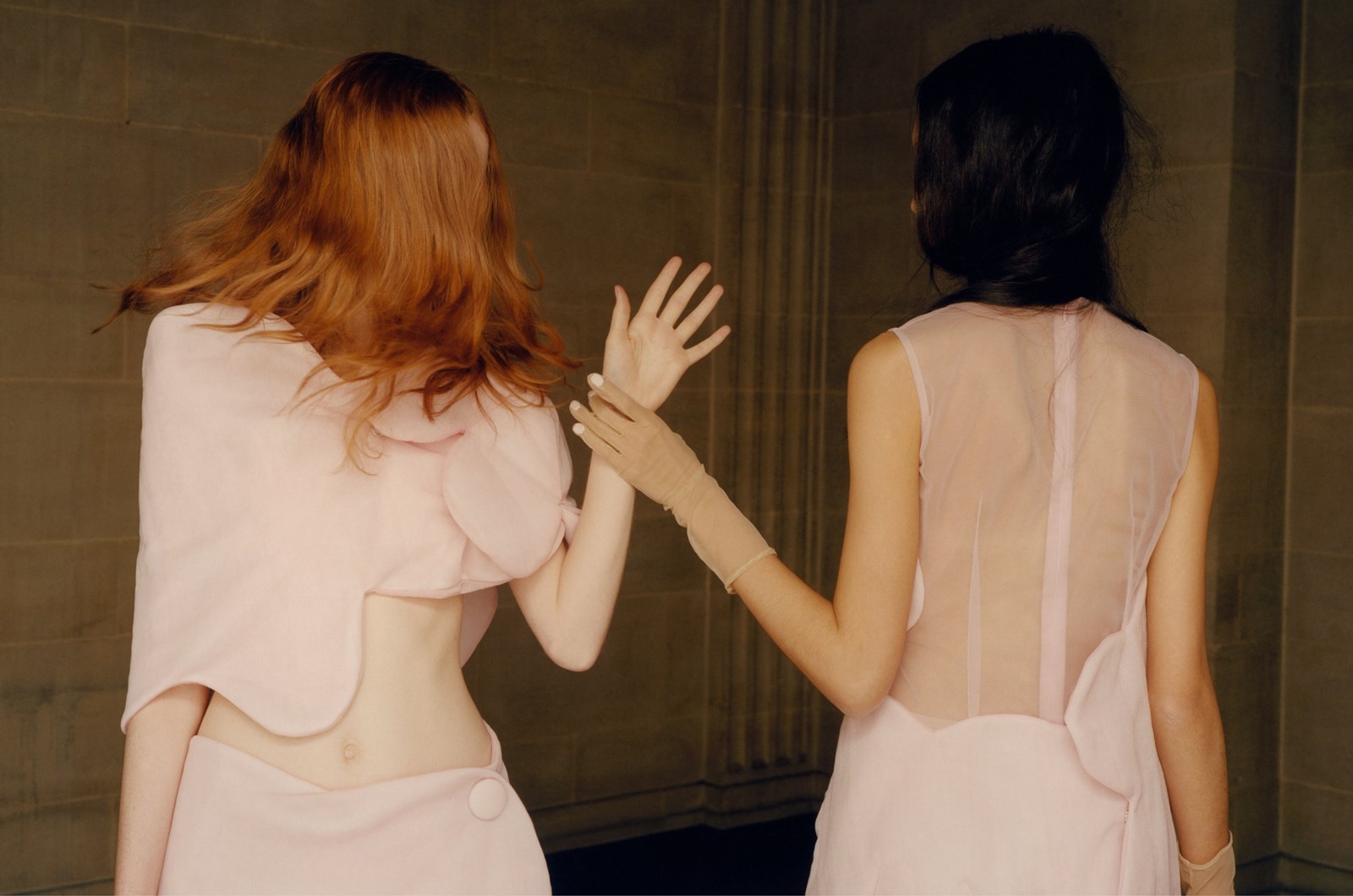
SR: Amazing.
CS: I still like the Centerfolds pictures, because my reason for making them wasn’t about abused women or anything like that. One story I refer to a lot in terms of how people perceive the work versus how I see it is an image of a blonde woman in bed referred to as “Black Sheets”. My idea was that she was waking up with a hangover after going to bed an hour before sunrise after dancing and drinking all night. Other people looked at it as if she was a rape victim. It used to worry me that some people would say, ‘Wow, this picture is so hot and sexy, I’m gonna hang her up over my bed!’ I’d be like, ‘Really?’ because my interpretation was completely different from what other people saw when they looked at my works, especially if I’m not titling things. That used to worry me, but then I realised I can’t really be concerned with how people look at art. You just can’t. Once you make it, you have to let it go and it lives its life. And if somebody can’t understand what my intention was, I can try to make them understand in the next series, but I’m not gonna try to hammer a message over peoples’ heads.
SR: Absolutely. And even if you did, it still wouldn’t matter. You make work because it’s personal, it’s coming from you, but it’s for people to see or wear, and you can’t control how they feel.
Simone Rocha is published by Rizzoli, and is out now.
in HTML format, including tags, to make it appealing and easy to read for Japanese-speaking readers aged 20 to 40 interested in fashion. Organize the content with appropriate headings and subheadings (h1, h2, h3, h4, h5, h6), translating all text, including headings, into Japanese. Retain any existing
tags from
Lead ImageUntitled #183, 1988Cindy Sherman
This interview is taken from Simone Rocha, published by Rizzoli.
Prosthetics, historical costumes, larger-than-life characters. Cindy Sherman is an artist who has been constructing and deconstructing female identities since the 70s. Whether framed as a critique, a defence, or simply an observation, Sherman’s characters — and their commentary on class, ageism, celebrity, and women’s role in society — harness the transformative power of clothing to show the world exactly who they are and how they want to be perceived. “I wish I could treat every day as Halloween and get dressed up and go out into the world as some eccentric character,” she once said.
Pushing the boundaries of the grotesque in her images, Sherman has drawn inspiration from the dark depths of history’s past to the strangeness of contemporary culture. Parodying the voyeurism of male painters, History Portraits (1981) tackled Old Masters portraits with patchy prosthetic breasts and squirting nipples, while her 2008 series Society Portraits put a nine-foot-tall lens on rich and powerful American socialites battling with women’s biggest taboo: ageing.
Much like Sherman, Simone Rocha is also fascinated with the idea of clothing as a signifier of strength and vulnerability — showing sensitivity while perversely pushing the dualities in her work. Subverting Elizabethan dress for Autumn/Winter 2014, she homed in on the toughness of Anne Boleyn and the dramatic proportions of her dress at a time when the only way women could take up space was with their clothing.
The emotional connection between clothing and identity also connects Sherman and Rocha. In 2022, Rocha invited Sherman to contribute works from her Bus Riders (1976) series to her exhibition girls, girls, girls at Lismore Castle Arts; a show that was a provocative ode to women artists like Louise Bourgeois, Harley Weir, and Josiane MH Pozi. With their subversive investigations into identity, womanhood, and dress, Sherman and Rocha talk about where they get inspiration from, the fine line between life and work, and the emotional connection between clothing and identity.
Cindy Sherman: I was thinking this morning, on my way back from the gym, about the first time I encountered your work. I think it was at Dover Street Market. I saw some of your pieces there and I bought a pair of heels — they were acrylic and see-through rubber with some pearls on them!
Simone Rocha: I was so excited and humbled when I found out that you were a customer. I was like, ‘Wow!’ because I’m such a fan. That’s the best bit of the job, when people you admire want to be a part of what you do. It’s the ultimate compliment.
CS: I can’t get enough of your stuff. I don’t know what it is that resonates with me so much, but I always feel really good when I’m wearing your clothes. Sometimes I think maybe I’m too old for some things, but there’s something about your clothes that feels very flattering for my body. You’re one of the few designers I feel I can really depend on when I want to look good and presentable.
SR: For me, clothes are like armour, like a uniform. They have a security to them, but I also love looking at an almost archaic kind of femininity … Cindy, I really wanted to ask you how you feel about clothes, because from the outside they’re such an important part of your work. Is that a tool or a hindrance?

CS: Clothes are definitely a tool in my work. It’s funny, I tend towards a lot of clothing that’s very costumey. There are some things I’ve bought over the years that I’ll probably never wear, like shoes that are just crazy high. Maybe I don’t fit into them anymore, but I’ll never get rid of them because they meant something to me at the time. They’re like pieces of art.
SR: Do you archive them?
CS: I finally got this storage place, so now it’s easy when I want to get something out of it. I just go online to their website and they deliver it to me.
SR: And where do you source clothes?
CS: Sometimes I’ve gone online, like on eBay, but that was more when I did the clown series. I wanted really colourful things, like big striped colourful T-shirts and ruffled square dance dresses that were perfect for some of the female clowns I was doing. If I’m working on something that’s really specific like that, then I’ll search online. Or I go to the Salvation Army and thrift stores, sometimes without anything in mind. If I see something that seems kind of outrageous, perhaps it will inspire a character. Even if I don’t know what I’m going to use it for, I’ll get it. The clothes I wear in my personal life are kind of different.
SR: It might feel too intimate to capture what you wear day to day?
CS: I’m trying to think if I’ve actually done that, because it’s possible. I also tend to cut things up for my costumes and use pant legs as sleeves, for example. I’m definitely not going to do that with some of my finer clothes that I wear for events, but there’s always the possibility.
SR: The series I’ve always felt really connected to are the History Portraits, Untitled Film Stills, and the Bus Riders. In each one, the identities are so extreme and so far apart from each other. As a designer, I felt really connected to the dress in those works, specifically with the History Portraits. How did that evolve?
“I’ve always been a little jealous of people who go to work and have to look nice every day. I feel like I have two sides of myself: the one wearing T-shirts, no makeup, and my hair pulled back, and the other one, where I go out to dinners, openings, or events and I have to look nice and put make-up on” – Cindy Sherman
CS: It started around 1987, when I was doing the Limoges porcelain series. I was inspired by this one design of a tureen that was supposedly designed by Madame de Pompadour, and I wanted to do a portrait based on her. I had this old-fashioned fake bustier that makes it look like you have big cleavage, and I threw some cloth around it. That was what started it and a few years later I continued with that theme. Later, I had a show in Paris that fell around Bastille Day on July 14, so I wanted to do some French Revolution characters. The next year, I was doing a residency in Rome, so then it became Italian-themed, and that’s how the whole series grew. At that time I was using pant legs as big fluffy sleeves, and I would cut things up and put them upside down to try and make them look like those outfits from that period.
SR: What I’ve always found interesting about historical dress is that it was a time when it was difficult for women to vocalise their opinions. Instead, it was about how much space they could take up in a room through dress because they couldn’t take up any space vocally. But they were always very covered up. So I loved the History Portraits where you show the breast.
CS: Thanks. That one with the breast, that’s actually based on a real portrait somewhere that I saw of a woman, just milk squirting out of her tit … How do you get inspiration?
SR: It completely depends. I do a collection once every six months, and each collection is very much a reaction to the previous collection. My Spring/Summer 2023 collection was about this idea of harnessing an emotion that you can’t take control of, and I wanted to do something that was very pastel and sickly sweet. As an antithesis to that, the next season, for Autumn/Winter 2023, I wanted to do something that felt very grounded and planted in the earth. I started looking more at Ireland and its traditions and rituals and how that could translate into physically making and weaving pieces. That’s the last two collections, but the ways I get inspiration change all the time. I love going to markets and flea markets and I have a big vintage archive that I love to turn inside out as well. I’m very physical — I don’t do a lot of sketching, I do nearly all of it on a model — and I write a big body of text on what the collection is about. It’s always on a body in the studio on one of our fit models, but then I’ll wear it, the team will wear it … there’s something about when you’re physically in different pieces, you can really think about the fabrication and the fit. For me, putting a human into it gives it a bit of identity.


CS: Have there been times when you’re wearing one of your own samples, and you suddenly realise, ‘Maybe this is too tight here’?
SR: Absolutely. And we’re actually so extreme. With some pieces, we’ll get everyone in the studio to wear it for a day or two to see how they feel.
CS: That’s great. It must be very fun working for you. [Laughs].
SR: Or the whole studio will be in a pair of shoes.
CS: Yeah, shoes are fun, too. I have a lot of shoes.
SR: They’re really fun but they’re actually the hardest part to do. They’re so technical, so ergonomic, but I love making playful shoes. So I’m thrilled that your first piece was a pair of shoes, actually. It’s very fitting.
CS: I think one of my favourite pieces right now is a dress I wore about a year ago to my first opening at Hauser & Wirth, the gallery I’m with now. It was the first show I did during the pandemic and even though it was older work, I was still pretty insecure. Especially having gained a little weight during the pandemic, that made me even more insecure. But I just felt so great in this dress. It was just so flattering, it didn’t matter. It was black — perfect! I also have a lot of pieces that I don’t fit into anymore. Some of them I bought like a week before the pandemic, when everything was shutting down, because I was about to have a show in March of 2020 at the Louis Vuitton Foundation in Paris, which was going to be a really big deal. So I wanted a couple of nice, beautiful dresses for being in Paris. Two months later, I was having a new show in New York, and I had all these things. I never wore them because I gained weight, and two years later, they don’t fit me, but I’m holding on to them because I’m determined to. They’re in my closet and I look at them and go, ‘Oh, I wanna wear that!’
SR: We can do an alteration. We can cut the legs off other things and stick them on!
CS: No, I’m determined to get back into shape.
“People are like, ‘Your weight is in your control,’ but it’s not really in your control. It’s hormonal, it’s emotional, and that’s so connected to clothes and identity” – Simone Rocha
SR: People are like, ‘Your weight is in your control,’ but it’s not really in your control. It’s hormonal, it’s emotional, and that’s so connected to clothes and identity. There’s such a fine line between your life and your work when you’re working within this kind of discipline. Sometimes I feel like I have to wear certain things to work, which is crazy. Even though I’m making clothes, you still have to think about what you’re going to wear to be able to do that. Do you feel like you need to wear certain things to work?
CS: Because I work at home and I work alone — I don’t have any assistants around — my uniform for the day is just a T-shirt and simple pants. I’ve always been a little jealous of people who go to work and have to look nice every day. I feel like I have two sides of myself: the one wearing T-shirts, no makeup, and my hair pulled back, and the other one, where I go out to dinners, openings, or events and I have to look nice and put make-up on. It’s like a different version of myself. But I am jealous of people who look nice all the time. When I go into SoHo to the stores to shop, the sales girls and guys look really great and pulled together and I feel so sloppy. And then when I’m actually shooting, it’s completely different because I’m picking out which clothes will create the character I’m trying to do. Sometimes the work is completely determined by the clothing — the clothing alone will give me an idea for the character — but sometimes it’s the wig or some other prop.
SR: How do you feel when you’re at an opening and you have to look at your work with the characters you’ve invented?
CS: It’s a little weird sometimes. I’m definitely used to it now because it’s been so long. I do feel like the pieces on the wall in the gallery are characters. I really don’t identify with them. I don’t feel like it’s me up on the walls, it’s like somebody else. Especially when it’s really old work, I don’t really relate to who I was then anymore… but it’s still kind of weird. This new body of work I just finished made me very self-conscious because of the little extra weight I gained, because I felt like I’ve always weighed the same throughout my whole career. And now that person — the constant of that canvas, which was me — has changed. So it was a little hard going back into shooting again, but I did.


SR: I was so grateful that you contributed to the girls girls girls show I curated at Lismore Castle Arts. I wanted to ask about the Bus Riders series you had in the show?
CS: I actually had a show back in 1976 that was on a bus, where they usually put the advertising above the seats. This was in Buffalo, New York, where I was going to college. I cut out little figures like dolls and glued them to a board on the bus. A couple of months later, people had ripped some of them off, but years later I decided to print out certain characters from that series. I dressed up like old ladies, old men, homosexuals, rebellious kids, women with groceries and housewife types. And I did some Black characters, which I’ve been criticised for. The criticism I got ten years ago was because they thought the white characters had various skin tones and that the Black characters didn’t, but that wasn’t true — I didn’t use any more elaborate skin tones for the white. I realised that at the time it was very naive of me, because there are a variety of Black skin tones. It never occurred to me, so that was really stupid on my part. It’s not really something I’m proud of, so we don’t show those works anymore.
SR: Time is changing so much now that we have to go back and think about all the things.
CS: Hopefully now we’re more aware.
SR: I just loved the realism in them. Some feel really realistic and then others are really cinematic and untouchable, like the Untitled Film Stills. Are they reactions to bodies of your own work?
CS: You mentioned earlier that you were inspired by your previous series, and I feel the same way. With things that I didn’t quite articulate well enough, or things that were a little misunderstood, I tried to go back and take that into consideration. That would definitely inspire the next series, or trigger something in it.
SR: Yeah, I think it’s impossible not to feel that. There’s almost something about a responsibility to the work that you’ve done.
CS: There’s one series I did that I refer to as Centerfolds or Horizontals which got criticism in the beginning from feminist critics who said they were too close to something you’d see in a true detective magazine of women thrown on the ground, looking up in terror. So the next series immediately after that were these more upright, vertical pictures. And the series that came right after that, which I called The Pink Robes, were pictures of women with a pink robe thrown over them, with the idea that they had just finished a photoshoot for a porno, and the photos are done while they’re just sitting there, covering themselves up.

SR: Amazing.
CS: I still like the Centerfolds pictures, because my reason for making them wasn’t about abused women or anything like that. One story I refer to a lot in terms of how people perceive the work versus how I see it is an image of a blonde woman in bed referred to as “Black Sheets”. My idea was that she was waking up with a hangover after going to bed an hour before sunrise after dancing and drinking all night. Other people looked at it as if she was a rape victim. It used to worry me that some people would say, ‘Wow, this picture is so hot and sexy, I’m gonna hang her up over my bed!’ I’d be like, ‘Really?’ because my interpretation was completely different from what other people saw when they looked at my works, especially if I’m not titling things. That used to worry me, but then I realised I can’t really be concerned with how people look at art. You just can’t. Once you make it, you have to let it go and it lives its life. And if somebody can’t understand what my intention was, I can try to make them understand in the next series, but I’m not gonna try to hammer a message over peoples’ heads.
SR: Absolutely. And even if you did, it still wouldn’t matter. You make work because it’s personal, it’s coming from you, but it’s for people to see or wear, and you can’t control how they feel.
Simone Rocha is published by Rizzoli, and is out now.
and integrate them seamlessly into the new content without adding new tags. Ensure the new content is fashion-related, written entirely in Japanese, and approximately 1500 words. Conclude with a “結論” section and a well-formatted “よくある質問” section. Avoid including an introduction or a note explaining the process.


